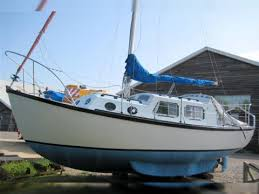jamie N
Well-Known Member
I've just seen a picture of a Husky, and the 1st thing that struck were the keels, very long and shallow on the hull, which is going to take an awful lot of turning effort to get her to tack, as her natural disposition is to only go straight ahead.
The rudder seems to be tiny as well, very much more in the line of a MoBo rather than a sailing yacht.

The rudder seems to be tiny as well, very much more in the line of a MoBo rather than a sailing yacht.


